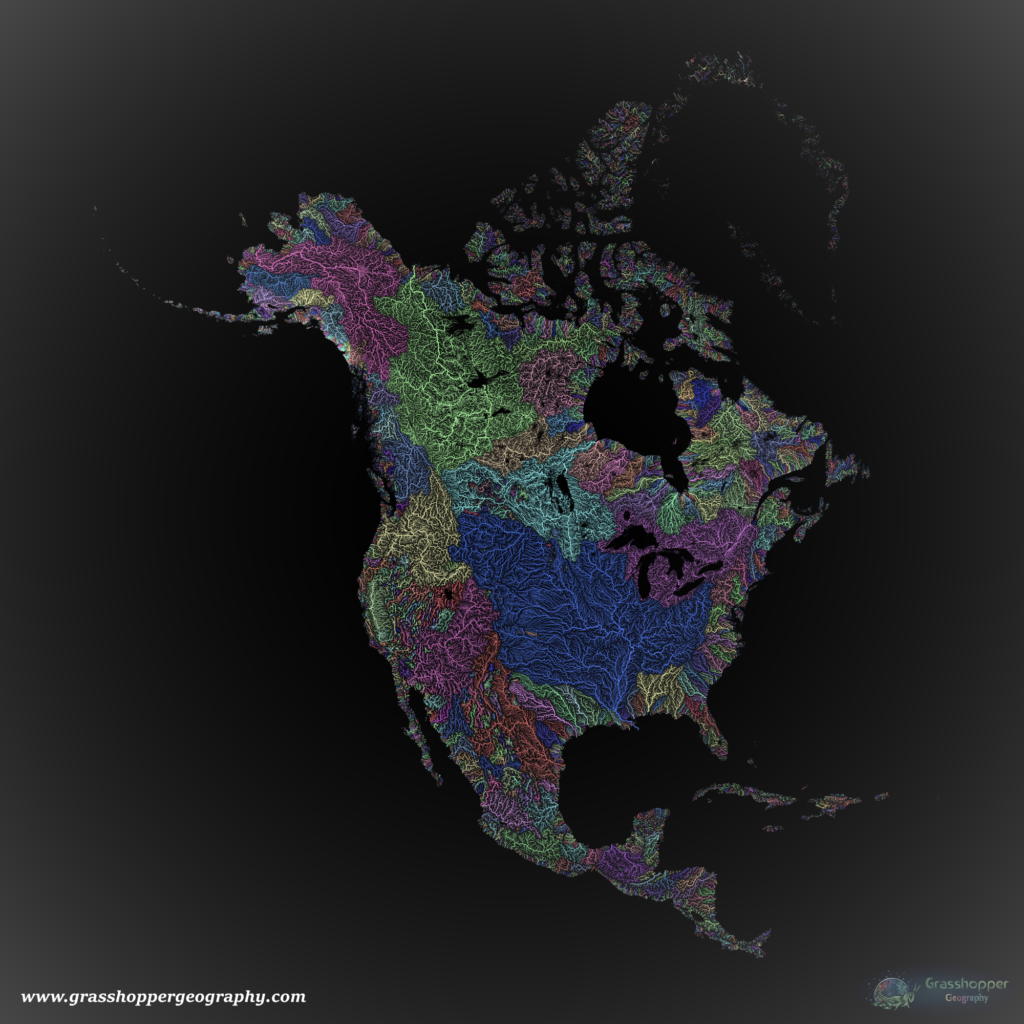
I was blown away when I came across this beautiful map of our continent, defined only by its watersheds. The map is the work of Robert Szucs of Grasshopper Geography and it shows us in an astounding visual how intimately connected land is with water. It also shows us how watersheds connect different regions of the land in an organic flow that does not respect the artificial boundary lines of our political jurisdictions. Water is vital to all life. Water flows from the sky to the land and traverses the land, hydrating it, providing life for all the land creatures and plants via the watersheds.
However, in our colonial culture, we have often taken the water cycle for granted. Nature has been generous to us and it has been easy to presume that water will be there for our needs and follow reliable seasonal patterns. But our human footprint on the earth has gotten so large that we have disrupted natural ecological systems which provided the resources we need. In this era of climate change we are experiencing serious disruptions to the water cycle, with violent storms, dramatic flooding, rising temperatures and increasing periods of drought.
Although we tend to focus on carbon as the culprit driving climate change, these weather disruptions that have become so prevalent are actually disruptions of the water cycle. Human interventions in natural ecosystem cycles have caused great imbalance to water cycles both global and regional. Forests and lush, diverse plant- covered environments play an important role in cooling and hydrating the earth as well as controlling rain cycles. As human activity displaces these natural ecosystems, we reduce the amount of plant cover and biodiversity on the planet. In doing so, we reduce the capacity of the earth to regulate temperature, absorb atmospheric carbon and retain water in the land.
If land is the body of our earth, water is the blood flowing through its veins. Without understanding the value of these vital systems and how they work, we risk destroying that which sustains our lives. Today, more people are starting to wake up and recognize that with extractive systems that exploit natural resources and no methodology for giving back and sustaining these vital systems, we are on a fast track to disaster.

Accounting for natural capital
I recently attended the BC Water Stewardship Symposium where, among other things, I heard about the work of two men, Emanuel Machado and Tim Pringle from Gibson and Salt Spring Island in BC who are developing ways of accounting for natural capital in their communities. Machado’s Municipal Natural Assets Initiative and Pringle’s Ecological Accounting Protocol are both ways that a community can take into consideration and maintain the natural assets which are so vital to the community’s well being.
Typically, a regional government has a budget and a maintenance plan for all the built infrastructure in their jurisdiction. Every pipe and drain is accounted for and there is money allocated to fix it if needed. But the grey infrastructure (pipes and drains) for water distribution is completely without value if the green infrastructure (the groundwater and streams) is not working. The green infrastructure is not valued nor accounted for. These accounting systems are a way of beginning to do just that. What is the worth of a stream or a wetland? What are the risks if it is lost? What is required to keep it functioning optimally? What lives depend on the well-being of this water? These are the questions that need to be asked. What is important is not so much the exact system or the dollar value, but the recognition that water bodies provide vital services such as aquifer recharge, storm protection, potable water, habitat, well-being, recreation and that we need to invest in maintaining and restoring them for the common good.
These two examples are focused on municipal jurisdictions, but as we see from the map, watersheds connect everyone who occupies and relies on the land. How can we all collaborate and begin collectively to develop systems to restore, maintain and value the water we all depend on for life?
Hydrating Landscapes to Mitigate Climate Change
This year, Regeneration Canada’s Living Soils Symposium will be called Hydrating Landscapes to Mitigate Climate Change. While this may seem like a departure from our usual focus on soil, we feel that healthy soil and water are inseparable. Soil without water is inhospitable and a balanced water system is critical for a secure food system. The issues farmers face with the problems around water scarcity and water excess cannot be resolved by farmers alone because water has no boundaries. Only as a united society can we begin to recognize the value of our natural capital and put in place ways to protect and restore it. Then we can build systems across jurisdictions which can collaborate and account for the protection of vital common resources.
Water scarcity and water excess are two faces of the same coin, not two different problems. We will learn from speakers and attendees at the Symposium how the water cycles work and how we can work together to help re-balance them across our landscapes. Everyone who depends on the land, from farmers to municipalities, to those who are concerned about our food security, has a role to play in creating change. We hope you will join us February 22-26 online for our Living Soils Symposium: Hydrating landscapes to mitigate climate change.
– ATTEND THE SYMPOSIUM –




